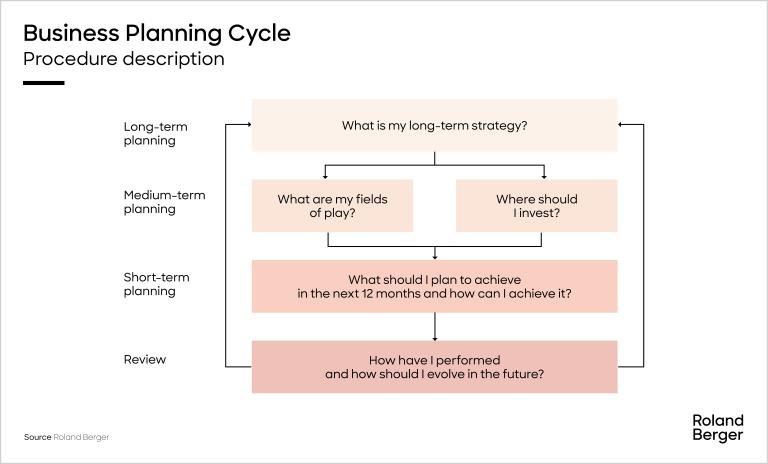

Business planning reinvention
By Julien Bourdinière and Mani Garg
Aligning short-term business planning to long-term strategic planning
"Consumer goods multinationals in Asia are entering a phase of turbulence. The time of fast growth is over when they benefited from a reputation of quality and novelty driving strong consumer demand. In this context, aligning long term strategic perspectives and short-term decision making is essential, but this requires many of them to enhance and align their business planning and budgeting processes."
Changing consumer behaviors, supply chain disruption, accelerated digitalization, sustainability transformation, AI and automation, in the next 10 years, consumer goods companies are expected to navigate more fundamental industry changes than in the past decade. To remain competitive, it is crucial for organizations to be both agile in their short-term operations and strategic in adapting their long-term plans to evolving macro-trends. This requires not only quick responses to market fluctuations but also the ability to continuously evolve their overarching strategies. However, global and regional consumer goods companies often face a significant challenge: locally, country business units tend to operate in a silo focusing on tactical, short term decisions without sufficient strategic vision and alignment, while at the headquarter, there is insufficient view on the operational realities at the local level. This disconnection leads to non-strategic short-term planning, inefficient investments, unaligned organization, and ultimately, deviation from the long-term ambition. Addressing this challenge requires much more than just adopting a new planning software. It demands a systematic transformation of the business planning process, effective change management, and diligent implementation of changes to build a resilient bridge between short-term operational plans and long-term strategic imperatives.
What are the elements of your planning process?
In every organization, there are various concurrent cycles within business planning process that culminate into long-term strategy definition and short-term operational plans. Based on our experience, these typically include the Strategy Cycle, the Portfolio Planning Cycle, the Investment Cycle, the Budget Cycle, and the Review Cycle. The best practice is to integrate and synchronize these plans across the company.
- Strategy Cycle: This refers to review of long-term [5 to 10 years] strategy of the organization, with a headquarter driven strategic directive and de-centralized strategy definition at business units (often defined based on geography or product categories), while considering market evolution and organization’s performance.
- Investment Cycle: This involves planning medium term [3 to 5 years] capital investments in supply chain, sustainability, technology upgrades, and workforce development. It could also include funding for new product development, process improvements, adoption of advanced technologies, acquisitions, and new market ventures.
- Portfolio Planning Cycle: This refers to medium-term initiatives [1 to 3 years] to define organization’s fields of play across products, brands, markets, channels, and customers. It involves identifying white spaces, setting organic & inorganic expansion directions, and consolidating market position vs. competition.
- Budget Cycle: This involves preparing and aligning the budget with strategic priorities and top-down targets, for the coming financial year. It covers topline planning across markets, channels, products & brands, and bottom-line & capital planning across functions to ensure optimal allocation of resources.
- Review Cycle: This involves regular (generally monthly and quarterly) evaluation of financial, commercial, and operational KPIs against the annual budget to assess performance and to identify variances with the key objective to take corrective measures and optimize performance for the rest of the year.

As organizations delineate these concurrent cycles of business planning, it is crucial for them to understand the interconnections among these. In a well-functioning process, the inputs and outputs of each cycle seamlessly flow into one another. Additionally, the level of detail is comprehensive yet limited. Right sequencing of these cycles and incorporating feedback loops among cycles leads to an efficient and effective Integrated Business Planning process. For example, in the absence of global long-term strategic direction, the medium-term investment planning could be sub-optimal and if the medium-term fields of play are not well-defined and not aligned with global strategy, the short-term budgets could deviate from the long-term ambition of the organization.
What are the potential gaps to watch-out for?
Even if the cycles and their interactions are well-defined, there could be other gaps that could limit an organization’s ability to implement a well-functioning integrated business planning process. At Roland Berger, we have defined ten dimensions of business planning process design and have consolidated best practices adopted in consumer goods industry.
- Strategic alignment
- Planning horizon & scope
- Target setting
- Planning timeline
- Data inputs * sources
- IT tools & systems
- Scenario planning
- Governance
- Documentation & reporting
- During-the-year review
Re-designing business planning process is not a simple task
Business planning redesign should not be viewed as a technology implementation program. While tools are important, the essence of re-engineering the business planning process lies in effectively aligning long-term strategy with short-term operational plans and fostering agility in decision-making.
Achieving success requires company wide-change management:
- Migration to standard "integrated business planning"
- Change management
- Inculcating a strategic thinking mindset
- Execution planning
"Integrating business planning with budgeting goes beyond technology – it's about aligning strategic vision with operational reality and success comes from embedding agility & collaboration into the process and ensuring every business unit & function is invested in the process."
Conclusion
Much has been said about Integrated Business Planning – mostly focusing on its technical dimension (implementing a new planning software) and on the integration of budget and execution (supply chain) planning.
Yet, a white spot with many complex organizations is the alignment of their long-term strategic ambition, often formulated at head-quarter level, and their short term, local yearly budget plans.
Adopting a structured and harmonized approach across countries, articulating top-down guidance and bottom-up execution plans and developing strategic planning skills among management team is an essential step, which appears a pre-requisite to any process and system driven transformation.
Register now to access the full publication and explore the strategies to enhance business planning in the consumer goods sector in Southeast Asia. Furthermore, you get regular news and updates directly in your inbox

